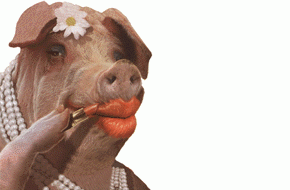
By Allan Barber
Silver Fern Farms released its annual loss accompanied by a press release which attempted to put some gloss on what was in reality an awful result.
It was an improvement on the year before, a matter of some pride on the teleconference this morning, but a $36.5 million loss was only $5.8 million less than the previous year.
The main improvement was in the cash flow deficit which at $5.1 million was a lot better than the deficit of $104 million in 2012.
Nevertheless chairman Eoin Garden’s statement that ‘the equity position at 39% (down from 41%) is healthy and the business platform is sound and competitive’ is a matter for debate and looks suspiciously like applying lipstick to a pig.
The reasons for the second consecutive loss are hard to argue with, but there must be some serious questioning going on between the banks and Pricewaterhouse Coopers’ consultants carrying out the strategic review of the company.
The main cause of the loss was the carryover of overvalued inventory into the 2013 financial year as well as the China and Russia hold ups which delayed sales before balance date at 30 September.
CEO Keith Cooper made mention of the decision to mark inventory to market to avoid further price depreciation.
He explained on the teleconference that the company had been too slow to sell inventory at the prices being offered in early 2012 in the belief the customers were using bargaining tactics, whereas they actually couldn’t sell the product bought at those levels.
SFF now sold into the market regardless of whether it was rising or falling.
-------------------------------------------------------------------------------------------------------------------------------------------
Farms For Sale: the most up-to-date and comprehensive listing of working farms in New Zealand, here »
-------------------------------------------------------------------------------------------------------------------------------------------
The press release and subsequent teleconference also covered the decision to focus on the core business, disposal or mothballing of assets like the Silverstream boning facility and Shannon pelt processing plant, and the transfer of livestock grazing commitments to a third party off balance sheet.
FarmIQ which has eaten up a lot of resources is now said to be nearly through its investment phase and coming to the point at which benefits will accrue. It will be interesting to see when and how these benefits will actually show up in future accounts.
On the positive side, beef, venison and co-products all provided good contributions to revenue and margins, although the sale of Shannon and the decision to reopen the Finegand casings plant indicates the volatile nature of co-products.
For the future SFF stated “We made some necessary investment in R&D to develop FarmIQ, a new livestock booking system, investment in plant reconfiguration, the Reserve beef range and Eating Quality Grading System, which are now operational and are set to bring returns and efficiencies over this coming financial year.” With respect, these are more part of continuous improvement than major game changers.
The company sees a better situation for the new financial year, mainly because the inventory overhang has cleared, China provides an important alternative to the traditional high paying markets of UK, EU and USA, and consumer demand will underpin prices. However there is concern the challenging dynamics of supply and demand will push lamb prices beyond what consumers are willing to pay.
If this sounds familiar, it’s actually what happened two years ago, although with the benefit of hindsight companies may be able to manage the situation better. At least there are fewer lambs around, so the inventory levels will inevitably be lower, but there is still a concern about the possibility of a procurement battle. This would force up the procurement price without automatically creating a corresponding increase in the market price.
The challenges of the new season centre mostly on managing the balance between lamb numbers and weights, procurement prices, prices to the consumer, and the respective volumes of product which are sold to UK, EU and China.
It will be an exciting season for all companies and how they respond to the challenge will have an impact on whether farmers continue to exit the sheep industry or decide to give it another year.
---------------------------------------------------------------------------------------
Here are some links for updated prices for
- lamb
- beef
- deer
- wool
P2 Steer
Select chart tabs
---------------------------------------------------------------------------------------
Allan Barber is a commentator on agribusiness, especially the meat industry, and lives in the Matakana Wine Country where he runs a boutique B&B with his wife. You can contact him by email at allan@barberstrategic.co.nz or read his blog here ».




We welcome your comments below. If you are not already registered, please register to comment.
Remember we welcome robust, respectful and insightful debate. We don't welcome abusive or defamatory comments and will de-register those repeatedly making such comments. Our current comment policy is here.